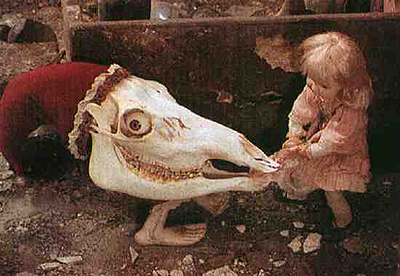

I must have seen the Disney version of
Alice in Wonderland
on TV when she and I were the same age. I watched it again just recently and remembered how spooky it was, especially the Cheshire cat. The poor girl, it seemed to me, was just trying to get along in the this strange world and no one will help her; they can only speak in riddles and nonsense.
In high school I discovered Martin Gardner's
The Annotated Alice
. I was fascinated by the fact that
Lewis Carroll was a mathematician and logician, and that the Alice stories were full of logical conundrums, linguistic inventions, propositional calculus and chess strategy. I also liked the way Carroll captured dream logic. In one scene, Alice is in a shop trying to focus on an interesting item on a shelf, but it is always on the next shelf above. When she tries to trap it at the top, it disappears through the ceiling.

I was quite tickled when the Jefferson Airplane had a hit with
White Rabbit, since it was based on what I was then seeing as an rather intellectual exercise. In college, the Disney film was in heavy rotation at campus film fests. Alice, her mushrooms, and the "hookah-smoking caterpillar" had now become psychedelic icons, the rabbit hole a gateway to an alternate reality. Like Carroll, I was equally fascinated by math and logic, and by the free form view of reality that nonsense provided.
This whole reminiscence of Alice started when I watched Jan Svankmajer's film,
Alice
. In this version a mostly-live-action Alice (sometimes transformed into a doll) chases a taxidermied rabbit that has broken out of its case and is leaking sawdust as he runs. She is beset along the way by an amazing variety of monsters and chimeras, such as he one shown above.
For more about this film, see
here (video clips),
here (part of a large Alice site) and
here (detailed commentary)
Labels: Literary




